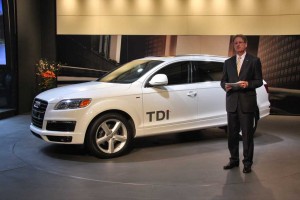
Audi turned to diesel power to help boost the mileage of the big Q7 but now it wants to address the problem by slashing the ute's weight.
Audi plans to trim the weight of its hefty Q7 sport-utility vehicle by as much 770 pounds. The maker is just the latest to announce plans to significantly cut the heft of its future products.
Ford Motor Co., for example, hopes to trim the weight on future product lines by as much as 20%, product chief Derrick Kuzak recently told TheDetroitBureau.com, while makers as diverse as Nissan and Land Rover are also setting aggressive weight targets as part of their efforts to meet tough new fuel economy standards.
Audi’s planned diet for the roughly 5,700-pound Q7 would amount to a significant 15% cut in weight, according to a report in Car & Driver magazine.
Meanwhile, the Volkswagen Touareg – which shares many of the same underlying components as the Q7 – has already dropped about 400 pounds with the current, second-generation model, as has the other Q7 sibling, Porsche’s Cayenne.
The weight cuts for the Cayenne and Touareg were achieved in a variety of ways, but most notably by eliminating the heavy low-range transfer case. Unfortunately, that’s not an option for the Q7 which never offered a low-range option.
Weight is the enemy of both performance and fuel economy, industry experts note. Every additional 100 pounds can cut mileage by as much as 1 mile per gallon.
The challenge is finding ways to trim weight without impacting such things as safety. In fact, upgraded safety standards – such as recent changes meant to reduce roof crush – are responsible for much of the added bulk the typical car has put on in recent decades.
But consumers are also to blame, demanding more and more features – such as high-end audio systems and onboard navigation screens – that also add to vehicle weight.
Audi marketing chief Peter Schwarzenbauer didn’t tell C&D how the maker will cut 770 pounds out of its Q7. Downsizing seems unlikely though the maker could expand the use of new lightweight materials, such as aluminum and even advanced composites.
A number of makers, notably including BMW, are investing heavily in the development of new carbon fiber technologies that could slash the cost of the high-strength, super-light material. BMW already has plans to use carbon fiber-reinforced plastics on its upcoming i3 and i8 battery cars.
In the run-up to the 2016 target of 35.5 mpg, never mind the 54.5 mpg federal target for 2025, cutting weight is expected to become one of the biggest challenges facing industry designers and engineers.
